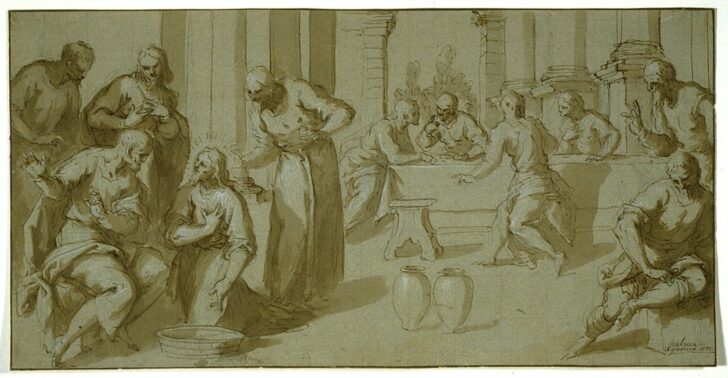Christ Washing the Feet of the Disciples
Palma il Giovane

Description
Here Palma used one of the favored Venetian drawing types to suggest form and color—the chiaroscuro drawing on blue paper, heightened with white. The sheet depicts the moment before the Last Supper when Christ washed the feet of the disciples. In the left foreground Peter is shown refusing Christ's offer of service, while astonished apostles look on. In the opposite corner, Judas, withdrawn, loosens his sandal. Other apostles in the background are already seated at the table. The push and pull from the left foreground to the middle ground to the right foreground—created in large part through the shading—effectively tells the story, as do the expressive gestures of the protagonists. We have hung this drawing close to Ricci's 18th-century painting of the Last Supper, where setting and gestures are also important.
The faint grid lines that we see here would have served as a means of enlarging the drawing to scale, suggesting that this composition was made in preparation for a painting. But no painting that completely matches this drawing is known.
Exhibition label text for "Venice, Traditions Transformed," September 21, 1996 - January 12, 1997 by Annette Dixon and Monika Schmitter.
After the death of the great Venetian master Jacopo Tintoretto (1519–1594), Palma il Giovane (the Younger) became the most revered artist in Venice. He worked largely for ecclesiastical patrons, and from 1600 on, he chiefly depicted themes relating to Christ, Mary, and the martyrdom of saints. Here Palma used one of the favored Venetian drawing types to suggest form and color—the chiaroscuro drawing on blue paper, heightened with white. The sheet depicts the moment before the Last Supper when Christ washed the feet of the disciples, an episode told only in the Gospel of Saint John (13:1-20), and Palma follows the text closely. In the left foreground Peter is shown refusing Christ’s offer of service, while astonished apostles look on. In the opposite corner, Judas, withdrawn, loosens his sandal. Other apostles in the background, already seated at the table, allude to the supper to come. The push and pull from the left foreground to the middle ground to the right foreground—created in large part through the shading and placement of the figures—effectively tells the story, as do the expressive gestures of the protagonists.
The faint grid lines that we see here would have served as a means of enlarging the drawing to scale, suggesting that this composition was made in preparation for a painting. But no painting that completely matches this drawing is known. The date 1575, inscribed in the lower right, is certainly incorrect; on the basis of comparison to other works by Palma, our sheet may date to 1615-1620 or the late 1620s
Gallery label text by Annette Dixon, Curator
Gallery Rotation Fall 2010:
Jacopo Palma il Giovane
Italy, 1544–1628
Christ Washing the Feet of the Disciples
1615–28
Pen, brown ink, and brown wash, heightened with white, on blue-gray paper
Gift through the Estate of Edward Sonnenschein, 1970/2.34
A consummate visual storyteller, Jacopo Palma begins this Gospel scene (John 13:1–20) at the table in the background, where four disciples animatedly discuss the Last Supper, which has just transpired. The storyline then shifts dynamically to the left foreground, where Christ kneels next to a basin and asks to wash the feet of one of his followers, Peter, while several other astonished apostles cluster around. Peter raises his hands in protest, but Christ, gesturing toward himself and the basin, replies, “If I wash thee not, thou, shalt have no part with me.” Balancing this group on the right sits the figure of Judas, pondering his plans to betray Jesus.
Subject Matter:
Derived from the New Testament story (John 13:1-17) of Christ washing the feet of his disciples at the moment of the Last Supper, Palma depicts the moment when Christ insists on washing Simon Peter’s feet. The disciple is hesitant to have his master perform such a humbling act, but Christ insists that this is setting a precedent for what the disciples will do after Christ is gone. Christ already knows that one of his disciples (Judas) will betray him, and the disciples pictured at the table in the background point to themselves as if they are questioning whether or not they will be the one to betray Christ. The scene is completed with classical imagery, in the columns of the architecture, the flowing robes, the vessels, and the muscular, expressive bodies.
Physical Description:
This pen, ink, and wash drawing on blue-gray paper is horizontally oriented. It portrays an open interior space, and on the left is a scene in the foreground with Christ with a halo, surrounded by four figures. Christ is kneeling before a seated man, with his right hand over his heart and his left arm indicating a basin of water on the floor. The seated man twists towards Christ with his arms stretching out away from Christ. All of the figures are dressed simply in flowing robes. The right side of the drawing portrays four figures in the background around a table by an open doorway gesturing in conversation. In front of the table are two vessels and a stool. At the far right, in the foreground, are two more figures, one seated on an object that bears the artist’s signature, and the other standing behind him and making a hand gesture towards Christ.
Usage Rights:
If you are interested in using an image for a publication, please visit https://umma.umich.edu/request-image/ for more information and to fill out the online Image Rights and Reproductions Request Form.